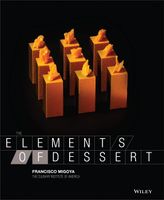Advertisement
Foamed Pastry Preparations
Published 2012
First, what is a foam? A foam is the dispersion of a gas or air in a liquid. Proteins in the egg whites and/or egg yolks are unfolded through beating at the interface between air and liquid. The main function of foamed eggs is to give volume, texture, structure, and grain to a batter. Egg whites will produce a lot more volume than egg yolks do, but sometimes a batter will call for both of these foams. Egg white can be whipped to eight times its volume, while egg yolk can be whipped to only four times its volume. The reason for this is because egg yolks contain large amounts of fat, which inhibits the intake of air. When egg yolks are whipped to their full volume, it is called the ribbon stage, because if you lift the whip or whisk away from them, the strand that is dripping from it will form what looks like a ribbon over the surface of the whipped yolks. The color of the yolks will also be a very pale yellow on account of all of the air that has been incorporated into them.

